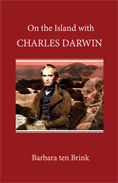
 |
Misael, a young man living on Isla Isabela in the Galápagos Archipelago, watches a new ship coming into the harbor. The local custom involves greeting the voyagers and, in the process, garnering a bit of income. When he learns that one of the new arrivals, Charles Darwin, plans to spend a week exploring the island, Misael decides to use his knowledge of the place and its people by offering his services as a guide. He approaches Darwin, and they converse in a mix of English and Spanish. Darwin admires the teen's spunk, since one of his cherished tenets is, "Those who learn to collaborate and improvise most effectively have prevailed." The two make a most compatible pair, with Darwin seeking all animal, vegetable, and mineral species for analysis, and Misael taking him to places where such samples can be found.
As the week progresses, the two help each other. Misael organizes the children of Isla Isabela to collect animals, vegetable, and mineral species, for which Darwin will pay. Darwin shows Misael how to use a telescope, immediately expanding the young man's natural intellect and curiosity. They ride horses and the large tortoises for which the archipelago is named. When Misael's family learns that Darwin is in a conflict with the ships' captain about a planned visit to the next island, Pinzon, to procure a rare saddleback tortoise, they secretly boat to Pinzon and bring back one of those remarkable specimens, much to Darwin's gratification.
Author ten Brink is an educator with a special zeal for inculcating a love of science in her students. In this latest offering, she creates a teacher/student relationship between Misael, a naïve young islander, and Darwin, the imminent scientist. His theory of evolution was first proposed in 1859, twenty-five years after his visit to Isla Isabela. She concludes her ingenious tale to the satisfaction of her readers. When he must finally be sailing on, Darwin writes a letter of thanks to Misael, who relates his reminiscences many years later, when he is working as a guide to tourists to the region and has named his children Charles, Darwin, and Isla Bela.
While clearly stating that this is a work of fiction and imagination, ten Brink provides ample evidence that she has researched the setting, the methodology used by Darwin, and the journaling that led to his seminal work, On the Origin of Species. Targeting her book to older children and young teenagers like Misael, she invites them to do further study of Darwin and the age and culture he lived in, as well as about the indigenous inhabitants and wildlife of the islands. She suggests several exercises, such as drawing some of the animal species named in the story and designing a family tree for Misael. The author organizes her narrative carefully and knows her potential readership extremely well. Her work should appeal to teachers and students alike, with its links to world history, scientific theory and fact, and the rich panorama of the sea and its creatures.
RECOMMENDED by the US Review